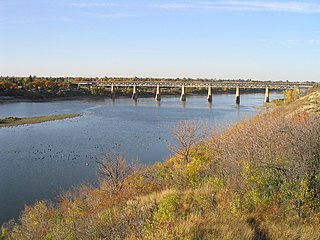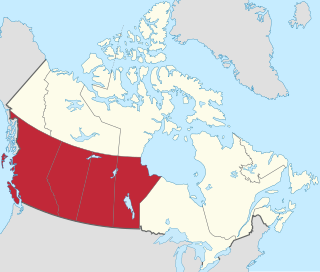Saskatchewan is one of Canada's provinces since 1905.
Contents
Saskatchewan (from the Cree language term kisiskāciwani-sīpiy, meaning "swift-flowing river"), may also refer to:
Saskatchewan is one of Canada's provinces since 1905.
Saskatchewan (from the Cree language term kisiskāciwani-sīpiy, meaning "swift-flowing river"), may also refer to:

Canada has ten provinces and three territories that are sub-national administrative divisions under the jurisdiction of the Canadian Constitution. In the 1867 Canadian Confederation, three provinces of British North America—New Brunswick, Nova Scotia, and the Province of Canada —united to form a federation, becoming a fully independent country over the next century. Over its history, Canada's international borders have changed several times as it has added territories and provinces, making it the world's second-largest country by area.
Athabasca is an anglicized version of the Cree name for Lake Athabasca in Canada, āthap-āsk-ā-w, meaning "grass or reeds here and there". Most places named Athabasca are found in Alberta, Canada.

The Saskatchewan River is a major river in Canada. It stretches about 550 kilometres (340 mi) from where it is formed by the joining of the North Saskatchewan River and South Saskatchewan River just east of Prince Albert, Saskatchewan, to Lake Winnipeg. It flows roughly eastward across Saskatchewan and Manitoba to empty into Lake Winnipeg. Through its tributaries the North Saskatchewan and South Saskatchewan, its watershed encompasses much of the prairie regions of Canada, stretching westward to the Rocky Mountains in Alberta and north-western Montana in the United States.

Events from the year 1905 in Canada.

The Saskatchewan Act is an act of the Parliament of Canada which established the new province of Saskatchewan, effective September 1, 1905. Its long title is An Act to establish and provide for the government of the Province of Saskatchewan. The act received royal assent on July 20, 1905. The Saskatchewan Act is part of the Constitution of Canada.
Assiniboia District refers to two historical districts of Canada's Northwest Territories. The name is taken from the Assiniboine First Nation.

Sir Frederick William Alpin Gordon Haultain was a lawyer and a long-serving Canadian politician and judge. His career in provincial and territorial legislatures stretched into four decades. He served as the first premier of the Northwest Territories from 1897 to 1905 as is recognized as having a significant contribution towards the creation of the provinces of Alberta and Saskatchewan. From 1905 on he served as Leader of the Official Opposition in Saskatchewan as well as Leader of the Provincial Rights Party. His legislative career ended when he was appointed to the judiciary in 1912.
The vastness of Canada's Northwest Territories meant that for much of its history it was divided into several districts for ease of administration. The number and size of these territorial districts varied as other provinces and territories of Canada were created and expanded. The districts of the Northwest Territories were abolished in 1999 with the creation of the Nunavut territory and the contraction of the Northwest Territories to its current size.

The 1905 Alberta general election was the first general election held in the Province of Alberta, Canada, shortly after the province entered Canadian Confederation on September 1, 1905. The election was held on November 9, 1905, to elect twenty-five members to the 1st Alberta Legislative Assembly.
Canadian Senate divisions refers to two aspects of the Senate of Canada. First, it refers to the division of Canada into four regional Senate divisions of 24 senators each, as set out in section 22 of the Constitution Act, 1867. The four regions are the Western Provinces, Ontario, Quebec and the Maritimes. These regions are intended to serve the Senate's purpose of providing regional representation in the Parliament of Canada, in contrast to the popular representation that the House of Commons is intended to provide. While not within any of the original four Senate divisions, Senate seats are also allocated to Newfoundland and Labrador and the three territories. The four divisions can be expanded when the need arises to have an extra two senators appointed to each regional division.
Victoria was one of the original 25 provincial electoral districts in Alberta, named for Fort Victoria on the North Saskatchewan River. It was mandated to return a single member to the Legislative Assembly of Alberta by the first past the post method until 1917, and by instant-runoff voting from 1926 until it was abolished in 1940.

The history of Northwest Territories capital cities begins with the purchase of the Territories by Canada from the Hudson's Bay Company in 1869, and includes a varied and often difficult evolution. Northwest Territories is unique amongst the other provinces and territories of Canada in that it has had seven capital cities in its history. The territory has changed the seat of government for numerous reasons, including civil conflict, development of infrastructure, and a history of significant revisions to its territorial boundaries.

The District of Athabasca was a regional administrative district of Canada's Northwest Territories. It was formed in 1882, was later enlarged, and then abolished with the creation of the provinces of Saskatchewan and Alberta in 1905. The very easternmost part is now within Manitoba.

The Red Coat Trail is a 1,300-kilometre (810 mi) route that approximates the path taken in 1874 by the North-West Mounted Police in their March West from Fort Dufferin to Fort Whoop-Up.

The following outline is provided as an overview of and topical guide to Saskatchewan:

Western Canada, also referred to as the Western provinces, Canadian West or the Western provinces of Canada, and commonly known within Canada as the West, is a Canadian region that includes the four western provinces just north of the Canada–United States border namely British Columbia, Alberta, Saskatchewan and Manitoba. The people of the region are often referred to as "Western Canadians" or "Westerners", and though diverse from province to province are largely seen as being collectively distinct from other Canadians along cultural, linguistic, socioeconomic, geographic and political lines. They account for approximately 32% of Canada's total population.

The following outline is provided as an overview of and topical guide to Alberta: